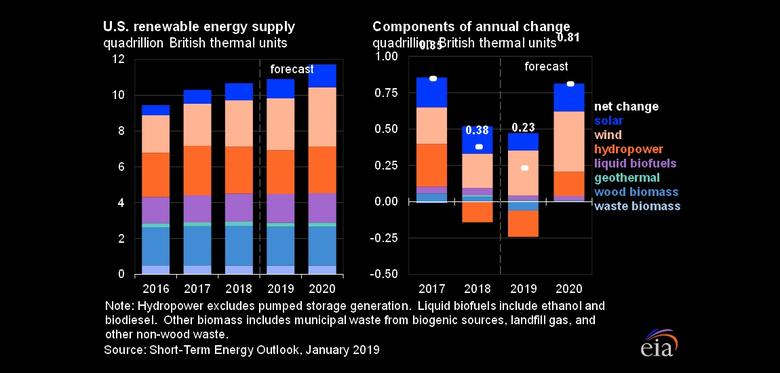
FASTEST RENEWABLE GROWING

U.S. EIA - EIA expects non-hydroelectric renewable energy resources such as solar and wind will be the fastest growing source of U.S. electricity generation for at least the next two years. EIA's January 2019 Short-Term Energy Outlook (STEO) forecasts that electricity generation from utility-scale solar generating units will grow by 10% in 2019 and by 17% in 2020. According to the January STEO, wind generation will grow by 12% and 14% during the next two years. EIA forecasts total U.S. electricity generation across all fuels will fall by 2% this year and then show very little growth in 2020.
EIA projects that the share of total U.S. electricity generation produced by all renewables other than hydropower will increase by three percentage points during the next two years, from 10% of total generation in 2018 to 13% in 2020.
This projected growth is a result of new generating capacity the industry expects to bring online. About 11 gigawatts (GW) of wind capacity is scheduled to come online in 2019, which would be the largest amount of new wind capacity installed in the United States since 2012. EIA expects electricity generated from wind this year will surpass hydropower generation. An additional 8 GW of wind capacity is scheduled to come online in 2020. The share of total U.S. generation from wind is projected to increase from 7% in 2018 to 9% in 2020.
Solar is the third-largest renewable energy source in the United States power sector, having surpassed biomass in 2017. The U.S. electric power sector plans to add more than 4 GW of new solar capacity in 2019 and almost 6 GW in 2020, a total increase of 32% from the operational capacity at the end of 2018. Because of this increase, solar is forecast to contribute slightly more than 2% of total utility-scale generation in 2020.
In addition to utility-scale solar in the electric power sector, some residences and businesses have installed small-scale solar photovoltaic systems to supply some of the electricity they consume. EIA forecasts that small-scale solar generating capacity will grow by almost 9 GW during the next two years, an increase of 44%.
Even with the growth from renewable energy sources, fossil fuels will still provide most of the electricity generated in the United States. Coal and natural gas combined provided 63% of electricity generation in 2018 and EIA forecasts that they will provide 61% in 2020.
Natural gas fueled 35% of total U.S. electricity generation in 2018, up from 24% in 2010. In contrast, the share of total generation from coal-fired power plants fell to 28% last year from 45% in 2010. EIA forecasts the natural gas generation share will grow to 37% by 2020 and coal will continue declining to 24% by 2020.
Coal was the predominant generation fuel in the United States for decades, but in 2016, annual U.S. electricity generation from natural gas-fired power plants surpassed coal-fired generation. Since then, natural gas has remained the primary source of electricity.
In addition to environmental regulations that led to retiring or modifying U.S. coal power plants, the electric power sector's switch to natural gas from coal has been driven by the sustained low cost of natural gas. Between 2016 and 2018, the price of natural gas delivered to electricity generators averaged about $3.25 per million British thermal units (MMBtu) compared with $5.09/MMBtu in 2010. Increased overall efficiency of the natural gas power plant fleet has also allowed natural gas to increase its market competitiveness.
-----
Earlier:

2019, January, 16, 11:30:00
GREEN ENERGY CONGRESS JUNE 2019GREENENERGY - We take an immense pleasure to extend our warm welcome to invite all the participants from all over the world to attend 7th World Congress and Expo on Green Energy during June 24-25, 2019 Barcelona, Spain
|

2018, December, 24, 12:00:00
U.S. PRIMARY ENERGY PRODUCTION 8.0 QUADRILLION BTUU.S. EIA - U.S. primary energy production totaled 8.0 quadrillion British thermal units (Btu), a 10% increase compared with September 2017.
|

2018, December, 7, 08:10:00
WBG GREEN INVESTMENT $200 BLNWBG - “There are literally trillions of dollars of opportunities for the private sector to invest in projects that will help save the planet,” said IFC CEO Philippe Le Houérou. “Our job is to go out and proactively find those opportunities, use our de-risking tools, and crowd in private sector investment. We will do much more in helping finance renewable energy, green buildings, climate-smart agribusiness, urban transportation, water, and urban waste management.”
|

2018, November, 30, 11:05:00
U.S. - JAMAICA COOPERATIONU.S. DT - U.S. Secretary of the Treasury Steven T. Mnuchin and Jamaican Prime Minister Andrew Holness today signed an Energy Framework to foster cooperation on energy and infrastructure investment in Jamaica. Secretary Mnuchin and Prime Minister Holness signed the Framework to Strengthen Infrastructure Investment and Energy Cooperation at the U.S. Department of the Treasury. The Framework is part of a U.S. initiative called America Crece, or the Americas Grow.
|

2018, July, 25, 09:10:00
RENEWABLE INVESTMENT DOWNFT - Capital spending in renewable power generation fell 7 per cent in 2017 compared with the previous year, owing to declines in onshore wind and hydropower investment, according to a report from the International Energy Agency. The world’s leading energy watchdog reported that overall global energy investment dropped 2 per cent in the same period.
|

2018, March, 28, 11:15:00
GLOBAL ENERGY DEMAND + 2.1%IEA - Global energy demand rose by 2.1% in 2017, more than twice the previous year’s rate, boosted by strong global economic growth, with oil, gas and coal meeting most of the increase in demand for energy, and renewables seeing impressive gains.
|

2018, March, 11, 11:15:00
U.S. RENEWABLE ENERGY: $1.4 BLNPLATTS - New York Governor Andrew Cuomo Friday announced that 26 large-scale renewable energy projects were selected to help the state meet its clean energy goals, and he pushed back against the Trump administration's offshore oil and gas drilling plans. |






